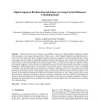Free Online Productivity Tools
i2Speak
i2Symbol
i2OCR
iTex2Img
iWeb2Print
iWeb2Shot
i2Type
iPdf2Split
iPdf2Merge
i2Bopomofo
i2Arabic
i2Style
i2Image
i2PDF
iLatex2Rtf
Sci2ools
109
click to vote
JCNS
2000
2000
Alpha-Frequency Rhythms Desynchronize over Long Cortical Distances: A Modeling Study
Neocortical networks of excitatory and inhibitory neurons can display alpha()-frequency rhythms when an animal is in a resting or unfocused state. Unlike some - and -frequency rhythms, experimental observations in cats have shown that these -frequency rhythms need not synchronize over long cortical distances. Here, we develop a network model of synaptically coupled excitatory and inhibitory cells to study this asynchrony. The cells of the local circuit are modeled on the neurons found in layer V of the neocortex where -frequency rhythms are thought to originate. Cortical distance is represented by a pair of local circuits coupled with a delay in synaptic propagation. Mathematical analysis of this model reveals that the h and T currents present in layer V pyramidal (excitatory) cells not only produce and regulate the -frequency rhythm but also lead to the occurrence of spatial asynchrony. In particular, these inward currents cause excitation and inhibition to have nonintuitive effects ...
| Added | 18 Dec 2010 |
| Updated | 18 Dec 2010 |
| Type | Journal |
| Year | 2000 |
| Where | JCNS |
| Authors | Stephanie R. Jones, David J. Pinto, Tasso J. Kaper, Nancy Kopell |
Comments (0)

